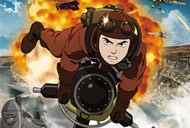
Steamboy
When in doubt, blow stuff up.
That seems to be the modus operandi for Katsuhiro Otomo, one of the most legendary directors in the anime world due to the feature film Akira. I have to disclose that Akira is possibly my favorite anime film; though it's not my most respected film in the genre, it is by far my most watched. I've watched all the official English-language dubs and subs of the movie; the first three times, I watched it in raw Japanese. And since Katsuhiro Otomo has actually directed precious little since Akira's debut, I was looking forward to Steamboy.
And to be honest, Steamboy is a great B-movie. It is Roland Emmerich and Jerry Bruckheimer filmmaking, ID4 and The Day After Tomorrow and Armageddon rolled into a package of steampunk adventure. For what it is, it's beautiful to behold. The problem is, it could be so much more. And like Otomo's infamous film, it ends in a gigantic blaze of glory...but whereas Akira ends with the creation of new universes as Tokyo explodes, Steamboy's ending is nothing more than the sum of its detonations. If Akira is faulted for being too complex, Steamboy can be faulted for being far too simple on almost all counts.
The plot revolves around Ray, a young boy whose eccentric father and grandfather are off in Alaska doing research on new inventions powered by steam in an alternate 1866. Local kids who think his father just ran off on his family pick on him, but Ray is certain this isn't the case, and he fights his bullies to protect his dad's honor. But Ray's problems with ruffians are just the start of it. From the moment Ray receives a package from his grandfather that contains a special "steam ball," villains are hot on his trail. The Foundation, a group involved with the World's Fair in London, tries to recover the device, nearly killing Ray in the process. His grandfather's note has him seek out Robert Stevenson, who supposedly will know what to do with it. Just as Ray meets Stevenson, however, he is kidnapped by dirigible!
When Ray meets his kidnappers, he is surprised to find that his father, declared dead by his granddad, is very much alive! It turns out the two look very differently at the uses of steam. One appreciates science for its own sake, while the other wants to be able to use it to industrialize the world and hopefully make it better. Meanwhile, the O'Hara Foundation, led by the precocious (and annoying) heir Scarlett, is interested in funding steam research for one reason: to make money. In the midst of all of this, Ray must find if his loyalties lie with his father, his grandfather, or a morality that neither of them can see from within their shortsighted visions of a world run on steam.
Steamboy looks stunning. The artwork is worth the $20 million reportedly sunk into its production, and it is amazingly detailed. Animation fans will find it one of the best productions the anime world has seen. And yet...there are certain aspects that don't yet feel quite right. Otomo has obviously fallen in love with 3D rotoscoping, and he uses it a few too many times to switch the point of view within a given shot. Though other animators are guilty of using a little too apparent computer work in their films -- there's one shot in the magnificent Spirited Away that looks off to me because of this, too, so I'm not picking on Otomo exclusively -- this film tries too many digital trick shots. Though breathtaking throughout, I think that Otomo could have gotten more mileage out of time-tested traditional techniques rather than the latest digital technology. It's minor, to be certain, but it's something I noticed.
I write this review of Steamboy based off of the theatrical dub version, which is missing 20 minutes of footage. Normally, this would disqualify a film from being reviewed on my site; however, Otomo personally oversaw and approved of this shortened version. For what it is, the dub is quite good. There are no terrible lines of dialogue -- or, if there are, the talents of Anna Paquin, Patrick Stewart, and Alfred Molina make up for them. Even the worst character of the bunch, Scarlett, is voiced effectively. One could debate the accents, which are not the best, but it's still a quality job.
In a surprising way, I'm glad I've seen this abridged version first, and it's because I'm not sure what exactly the extra 20 minutes would do for this film. It is a very by-the-numbers action-adventure film. It may add some deepened character moments, which frankly this version is lacking. And yet, the extra time cannot really fix the primary issue with the film: it is too simple to sustain even an hour and forty-five minute running time. Even if the extra footage were to add a deleted character or some subplot, it is very unlikely to change the motif of the film. In fact, because it feels a little long now, the extra 20 minutes may well be excised. I'll note an addendum to the film once I've seen the original cut to see how they compare.
The other weak link in this film is the character of Scarlett. She exists primarily to create a same-age foil for Ray, since all the other players are adults to Ray's teenager. But how annoying can one character be? She factors into a few key scenes, but her personality is so shrill that it began to pain me whenever she was on screen. She makes the character she was patterned after -- Scarlett O'Hara from Gone With The WInd -- look practically radiant in comparison. In this character, Otomo broke a cardinal filmmaking rule...you can have evil, even wicked characters in your films, but don't make them so annoying you lose your audience. Did he ever see Jar-Jar in Episode I? Scarlett is not quite that bad, but close, and she takes the film grade down a small notch.
Now, after my complaining, I have to tell you that I had a good time at Steamboy. It is a fun summer popcorn flick, one you enjoy and talk about with your friends for a half-hour about the cool parts and then promptly dismiss. For what it is, I'd much rather watch it than many other blockbusters in its filmic category. The action is really something to watch; Ray's escape and subsequent kidnapping in the first twenty minutes is almost in and of itself worth the price of admission. The concept of "steampunk" itself is really fun, and all the nifty contraptions that run on steam ramp up the cool factor. I think kids between say 10 and 15 would have an utter blast at this movie, and that part of the kid left in me thought this was really something special.
But as an Otomo fan, I can't help but be a little disappointed. After the recent release of the philosophical (and possibly even more gorgeous) Ghost in the Shell 2: Innocence, I was hoping for a film with a little bit more intellectual "oomph." I liked that Akira required multiple viewings to understand all the layers. Steamboy requires nothing from the audience, and the only philosophical concept running through the film is "war is a bad use of good science," which is really only a token expression of anything meaningful.
But can I judge the film like this, for what it does not aspire to be? I don't think so. I think it is an entertaining example of a true B-grade movie, and that's the grade it shall receive. I will rent the extended edition when it comes out on DVD and be entertained again, and perhaps I'll think more highly of it then. But Otomo put years of work into fleshing out the world of Akira in manga form well before it became a movie. Though Steamboy took nearly ten years to reach the silver screen, the time it spent in limbo should have contributed more to its weight. Instead, I think that Otomo put together a film that had ten years worth of baggage. Had he taken the same care with the creation of the world of Steamboy as he did Akira, I think it would have been a more enjoyable experience overall rather than just light entertainment.
Steamboy -- violence -- B

